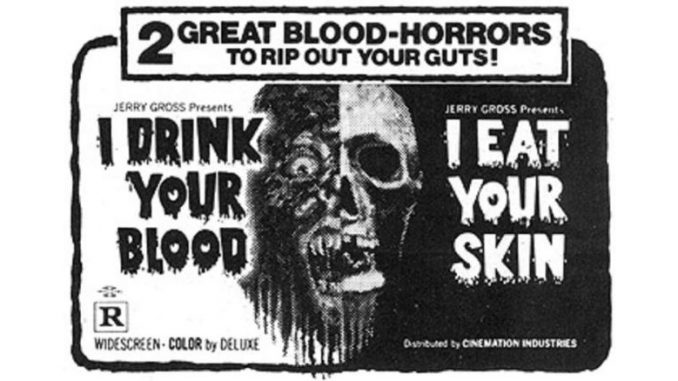
Rating: B-/D+
I Drink Your Blood and I Eat Your Skin represent perhaps the most quintessential pairing of drive-in movies in cinema history. I first heard about them courtesy of Joe-Bob Briggs, who called it, “the most religious double feature ever made.” This was back in my British days, when even the very concept of the drive-in was a strange and exotic idea, never mind the lurid content which was reported to play there. Of course, when I actually got to see the reality, it proved rather less than the illusion. My first drive-in trip, back in March 2001, was for a double-bill of The Pledge and Valentine, and was such an underwhelming experience, I never went back. I blame Denise Richards and David Boreanaz.
But this double-bill is an excellent example of promotional technique by the distributors, Cinemation, run by the appropriately-named Jerry Gross. The company operated through the mid-seventies, getting their start with titles such as Teenage Mother, which included both a reel of genuine childbirth footage and the film debut of Fred Willard. But they also kept busy in other fields, such as Mondo Cane and its knock-off version Africa Addio, which was renamed to Africa Blood and Guts. In their later days, Cinemation also released Fritz the Cat, and even Turkish Delight, an early work by some arthouse director by the name of Paul Verhoeven, which starred a then-unknown actor called Rutger Hauer.
Here, they took two completely unrelated movies, one of which had been sitting on the “unreleased” shelf for more than five years, and retitled them both, in order to create an entirely spurious connection. Brilliant! Although probably also the least subtle retitlings since Eyes Without a Face became The Horror Chamber of Dr. Faustus for drive-in consumption (on a double-bill with The Manster) – but this isn’t exactly a field known for underselling its product. So it is here, because neither film lives up to its new title. Though really, how could they? That said, one of this pair comes a great deal closer than the other…
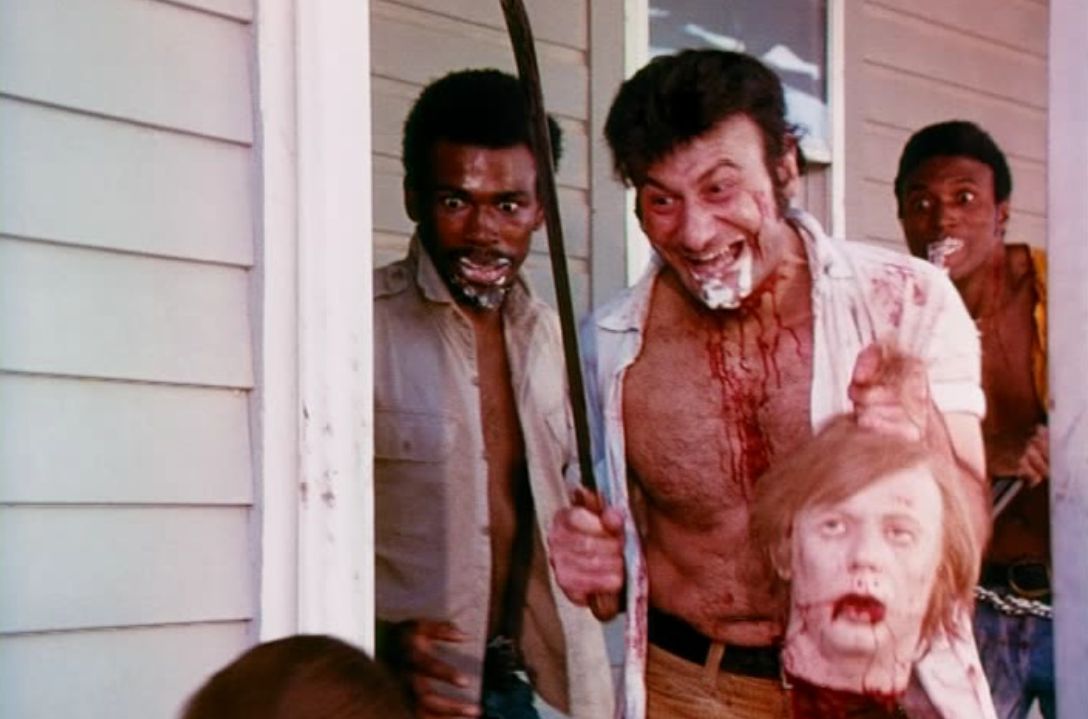
I Drink Your Blood (1970)
Rating: B-
Dir: David E. Durston
Star: Bhaskar, Iris Brooks, Riley Mills, Tyde Kierney
Originally titled Phobia, it’s a product of the early seventies, when the post-Woodstock backlash against the hippies was in full swing. Subsequent events had turned the tide of public opinion against them in just a few months. In December 1969, the Altamont Festival saw an attendee, high on meth, stabbed to death by one of the Hell’s Angels who were providing security. But it was the revelations about Charles Manson and his acolytes, indicted the same month, which was likely the true death-knell for peace, love and the hippie way. They’re clearly a big influence on the story here, which sees a neo-religious cult, SADOS (Sons and Daughters of Satan), end up in a small, rural town after their van breaks down.
Tensions are high from the start, after local girl Sylvia (Brooks) is assaulted by the gang, under the leadership of Horace Bones (Bhaskar). Her grandfather, the local doctor, goes to remonstrate with them, but is disarmed, fed LSD and sent on his way. It’s up to local kid Pete (Kierney) to take revenge, and you’ve certainly got to give the young ‘un credit for imagination. After shooting a rabid dog, he uses his grandpa’s medical gear to extract infected blood from the corpse, and injects it into meat pies, which he then sells to the hungry, hungry hippies. In defiance of the usual 3-8 week incubation period for rabies – the film blames drug use – within a couple of hours, they’re frothing at the mouth, then attacking locals, each other and the workers on a nearby engineering project.
While rarely less than ludicrous, it’s effectively realized by Durston, with enough enthusiasm that this was apparently the first movie ever slapped with an ‘X’ certificate (introduced in November 1968) purely for violence. It plays a little like Night of the Living Dead, with counter-culture zombies posing a threat, not just to the established order but also themselves, as the SADOS turn on their own kind [perhaps a nod to Manson’s part in derailing the sixties]. The makers were helped by lucking into a good location. The town of Sharon Springs in upstate New York had a lot of deserted buildings, with which the production was allowed, more or less, to do as they wished. The resulting rampage of destruction certainly delivers good value for its low-budget dollars.
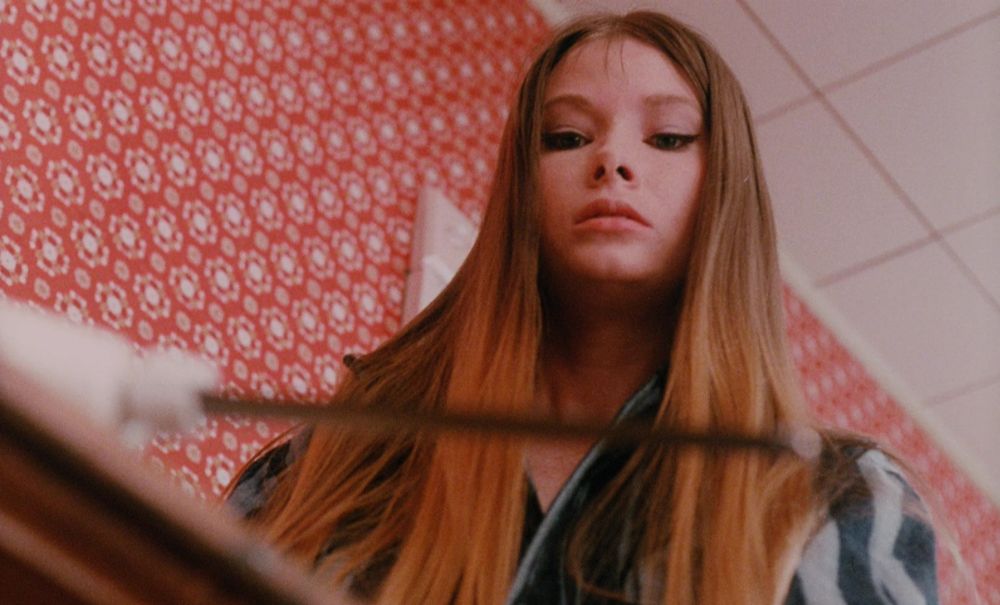 Durston came up with the concept in response to a request from Gross, combining the topical Manson case with a story he’d read about rabid wolves attacking a Iranian schoolhouse [which sounds fascinating, if completely unverifiable]. This seems to have been his sole foray into the horror genre, in a career which otherwise took him from variety TV to sexploitation. The cast are mostly as obscure, but among the uncredited are Arlene Farber, who’d go on to appear in The French Connection, and Lynn Lowry, later part of the not-dissimilar The Crazies. Lowry was a late addition to the cast, playing a mute member of the SADOS – that way, Durston didn’t have to write her any lines, though she gets a memorable scene involving an electric carving-knife (above), before vanishing from the film. Lowry actually asked not to be credited, as the young actress was concerned word would get back to the TV network for whom she was then working on a soap-opera.
Durston came up with the concept in response to a request from Gross, combining the topical Manson case with a story he’d read about rabid wolves attacking a Iranian schoolhouse [which sounds fascinating, if completely unverifiable]. This seems to have been his sole foray into the horror genre, in a career which otherwise took him from variety TV to sexploitation. The cast are mostly as obscure, but among the uncredited are Arlene Farber, who’d go on to appear in The French Connection, and Lynn Lowry, later part of the not-dissimilar The Crazies. Lowry was a late addition to the cast, playing a mute member of the SADOS – that way, Durston didn’t have to write her any lines, though she gets a memorable scene involving an electric carving-knife (above), before vanishing from the film. Lowry actually asked not to be credited, as the young actress was concerned word would get back to the TV network for whom she was then working on a soap-opera.
It’s undeniably schlocky, playing very much like a Herschell Gordon Lewis effort – a mixed blessing! – and is hurt by uneven pacing. But that’s a chunk of the charm, and when it eventually gets going, the film makes strenuous efforts to make up for lost time. Even if the title is only tangentially accurate (unless “you” happen to be a dead, formerly rabid canine), I imagine most of the seventies audience would have headed to the concession stand at half-time, feeling like they had got their money’s worth so far. They would probably have been better off if they’d kept heading out of the drive-in at that point, abandoning their dates, small children and cars. For chugging down some infected blood would likely be preferable to the other part of the double-bill with which this was paired.
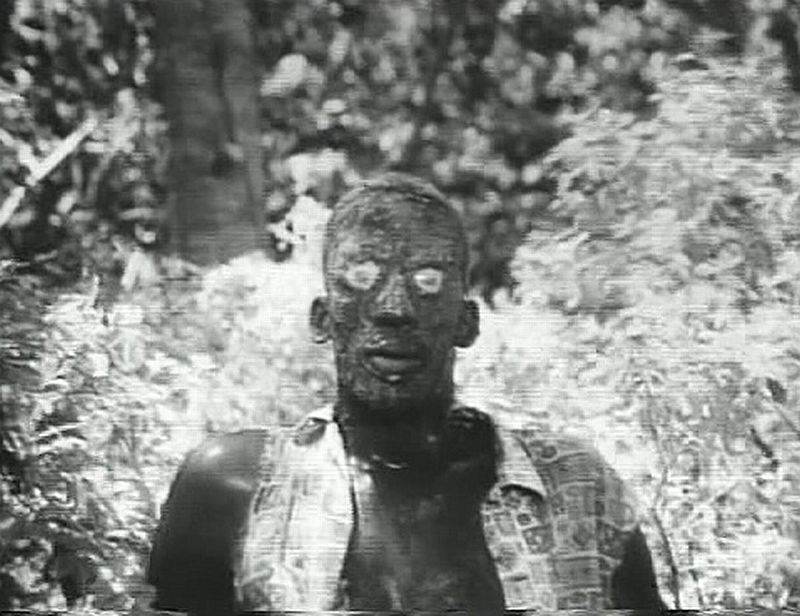
I Eat Your Skin (1964)
Rating: D+
Dir: Del Tenney
Star: William Joyce, Heather Hewitt, Charles Coy, Dan Stapleton
Known originally as Zombie – or, perhaps, Zombie Bloodbath – the six years this spent languishing, distributor-less, certainly did not work for the film. Because between its filming in 1964, and eventually seeping out under a zombie-free Cinemation retitling in 1970, on a double-bill, the entire Z-landscape was changed forever by George A. Romero with Night of the Living Dead. Before, zombies were Val Lewton-esque creatures, typically shambling round Caribbean plantations (or Cornish tin-mines, as in 1966’s Plague of the Zombies) at the behest of their masters. But a new decade brought new expectations, and an audience riled up by Blood will have found this Skin-flick a thoroughly disappointing experience.
Tenney had found some success with The Horror of Party Beach, which received far broader distribution than it deserved, and attempted to follow up with another horror-ish seaside pic. The hero is Tom Harris (Joyce), ladies’ man and writer of potboiler fiction (apparently inspired by Harold Robins), taken by his publisher (Stapleton) to an island to get inspiration from the voodoo religion still practiced there. There’s also the island’s overseer (Coy), and a scientist investigating the use of snake venom to cure cancer, who just happens to have an attractive virgin daughter, Jeannie (Hewitt), that needs rescuing. Well, from her virginity, anyway. For it turns out the locals descend from a tribe who practice human sacrifice, and now need an offering to appease their god, Papa Negro.
There’s a zombie elephant in the room here. It is made clear that blonde virgins are the sacrifice of choice. But it’s also apparent – well, as apparent as a mainstream film could get in 1964, i.e. vague winking – that Jeannie’s hymen did not survive the first night of Tom’s island sojourn. Problem solved! [Well, maybe they should dye her brunette too, just to be safe.] But purity is never mentioned again, the film preferring to have lengthy sequences of poorly-made up islanders (above), who look like they have ping-pong balls stuck to their eyes, shambling round the island in slow pursuit of Tom and Jeannie. In case you’re wondering, leaving the island has become impossible, thanks to a kamikaze zombie, who charges at top undead speed into their plane, carrying a large box marked “EXPLOSIVE” (below).
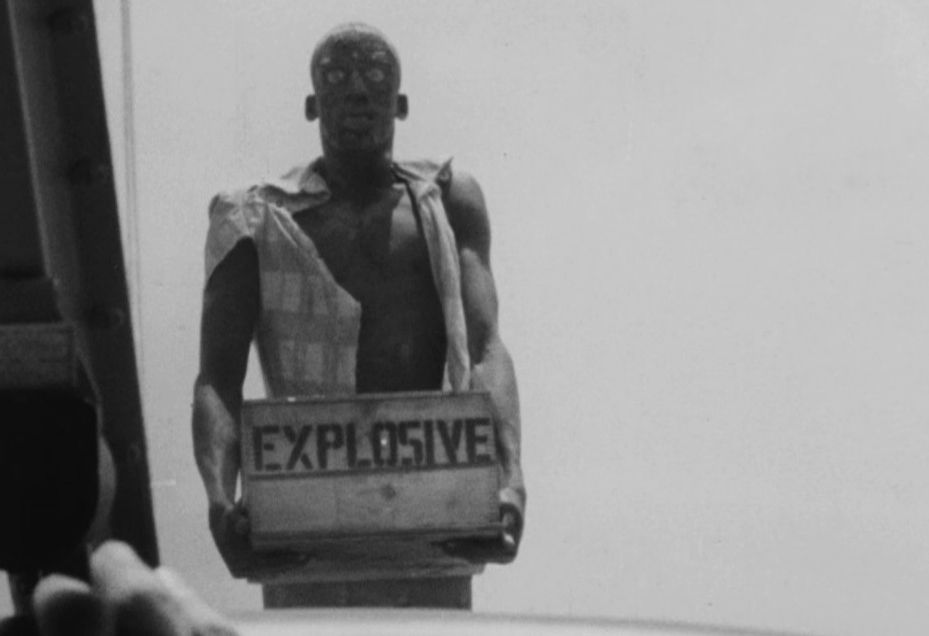
There is some amusement to be had here, albeit of the “bring your own fun” kind. For example, you could drink every time someone in the film does. Because, damn, people chugged it down in the sixties. Bonus: this would bring rapid unconsciousness, allowing you to avoid the rest of the film. You can also wince at the feeble attempts at comedy, as Tom is caught hanging about with someone else’s wife in Miami, or the eccentric character stylings of his publisher’s wife and her dogs [the IMDb lists the supplier of those animals as Diane Reese-Poodles. I’m thinking the IMDb misread the credit “Diana Reese – Poodles”. Or perhaps she married Mr. Poodles?] Oh, and early scenes were shot at the Fontainebleau Hotel, a Miami landmark used the same year by Goldfinger. So there’s that.
Under different circumstances, this might just about have passed muster. However, those circumstances would include: a) Being paired with a different, more similar film for its double-bill than I Drink Your Blood, b) Having a name that is a reasonable representation of the contents, and c) Getting released in 1964, instead of 1970. Instead, it’s pretty much a triple whammy of problems, from which a much better film would struggle to recover, and is a case where the marketing is far more notable than the movie.
